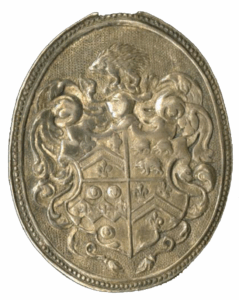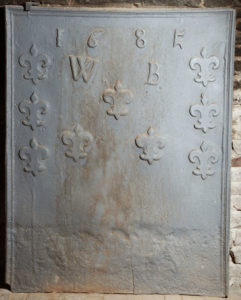
On their website Herefordshire Libraries have a black and white photograph of this fireback, which is at Fawley Court, Brockhampton. Taken in the early years of the last century by the antiquarian Alfred Watkins, it shows more clearly the crack across the lower part of the plate. Cracks across firebacks caused by temperature differentials are not uncommon. However this crack is more than it seems for it hides an entire missing portion of the fireback.

The arms on the fireback, which are of the Kyrle family of Much Marcle in the same county, are notable for their crest of the hedgehog, or urchin as it is sometimes called in heraldry. Sir John Kyrle may have operated an iron furnace at Whitchurch, between Monmouth and Ross, and so may have had the back cast there. The carver of the pattern for the fireback was also responsible for a couple of other firebacks that I have noted. The date on the fireback, however, is suspicious as the ‘2’ seems stylistically different to the other numbers and may indicate that it was changed, from a ‘1’ perhaps, before this casting was made.

Down to the south-east, in Gloucestershire, lies the village of Flaxley where there was another iron furnace that, in the late-17th century, was owned by William Boevey. He lived at Flaxley Abbey where there were a couple of firebacks that bear his initials (one was sold recently). Both have the date 1685 of which the ‘5’ is particularly distinctive, having a minimal curve at the bottom.

The same date with the curious number five turned up on a Kyrle fireback recently which solves the question of the missing portion of the one at Fawley Court. Trailing tassels from the heraldic mantling are missing from the Fawley Court casting, a cunning bit of blacksmithing having rejoined the broken parts. Evidently the original pattern for the Kyrle fireback, or more probably an existing fireback, was used to make another casting, but this time at Flaxley for it would have been at that furnace that the stock of numbers included the distinctive ‘5’.